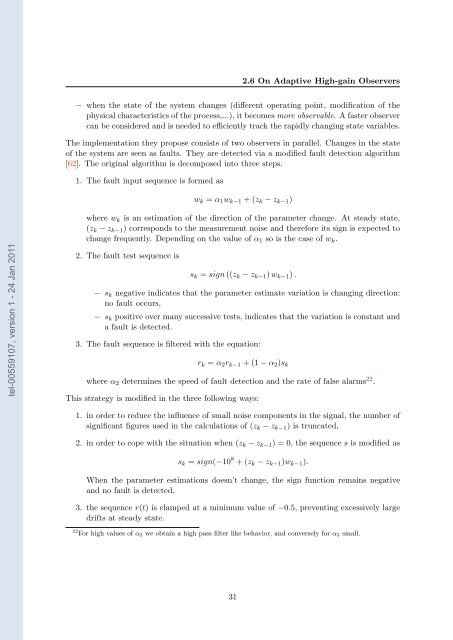Adaptative high-gain extended Kalman filter and applications
Adaptative high-gain extended Kalman filter and applications
Adaptative high-gain extended Kalman filter and applications
You also want an ePaper? Increase the reach of your titles
YUMPU automatically turns print PDFs into web optimized ePapers that Google loves.
tel-00559107, version 1 - 24 Jan 2011<br />
2.6 On Adaptive High-<strong>gain</strong> Observers<br />
− when the state of the system changes (different operating point, modification of the<br />
physical characteristics of the process,...), it becomes more observable. A faster observer<br />
can be considered <strong>and</strong> is needed to efficiently track the rapidly changing state variables.<br />
The implementation they propose consists of two observers in parallel. Changes in the state<br />
of the system are seen as faults. They are detected via a modified fault detection algorithm<br />
[62]. The original algorithm is decomposed into three steps.<br />
1. The fault input sequence is formed as<br />
wk = α1wk−1 +(zk − zk−1)<br />
where wk is an estimation of the direction of the parameter change. At steady state,<br />
(zk − zk−1) corresponds to the measurement noise <strong>and</strong> therefore its sign is expected to<br />
change frequently. Depending on the value of α1 so is the case of wk.<br />
2. The fault test sequence is<br />
sk = sign ((zk − zk−1) wk−1) .<br />
− sk negative indicates that the parameter estimate variation is changing direction:<br />
no fault occurs,<br />
− sk positive over many successive tests, indicates that the variation is constant <strong>and</strong><br />
a fault is detected.<br />
3. The fault sequence is <strong>filter</strong>ed with the equation:<br />
rk = α2rk−1 + (1 − α2)sk<br />
where α2 determines the speed of fault detection <strong>and</strong> the rate of false alarms 22 .<br />
This strategy is modified in the three following ways:<br />
1. in order to reduce the influence of small noise components in the signal, the number of<br />
significant figures used in the calculations of (zk − zk−1) is truncated,<br />
2. in order to cope with the situation when (zk − zk−1) = 0, the sequence s is modified as<br />
sk = sign(−10 8 +(zk − zk−1)wk−1).<br />
When the parameter estimations doesn’t change, the sign function remains negative<br />
<strong>and</strong> no fault is detected,<br />
3. the sequence r(t) is clamped at a minimum value of −0.5, preventing excessively large<br />
drifts at steady state.<br />
22 For <strong>high</strong> values of α2 we obtain a <strong>high</strong> pass <strong>filter</strong> like behavior, <strong>and</strong> conversely for α2 small.<br />
31

















